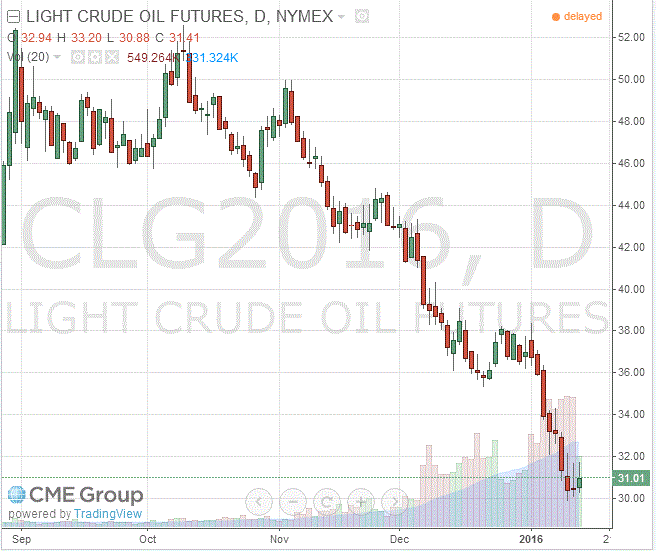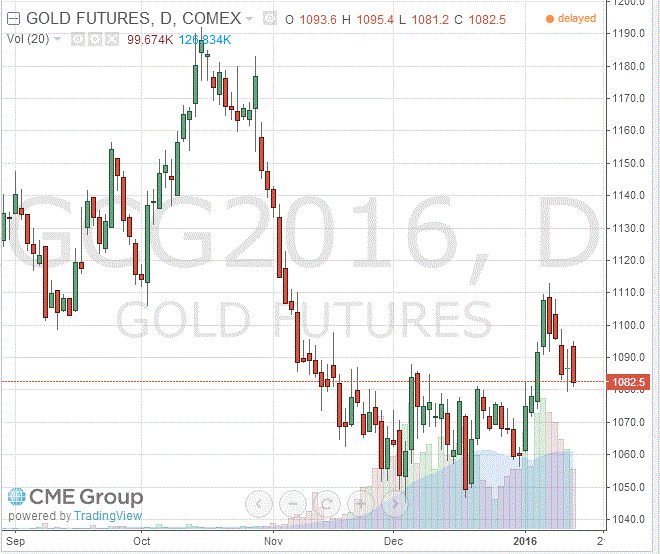Noticias del mercado
-
17:53
Oil prices rise despite a stronger U.S. dollar
Oil prices rose despite a stronger U.S. dollar. But gains were limited by concerns over the global oil oversupply. Iran plans to boost its oil exports once the sanctions are lifted off.
Market participants continued to eye yesterday's U.S. crude oil inventories data. According to the U.S. Energy Information Administration (EIA), U.S. crude inventories increased by 234,000 barrels to 482.6 million in the week to January 08. Analysts had expected U.S. crude oil inventories to rise by 2.6 million barrels.
Gasoline inventories increased by 8.4 million barrels, according to the EIA. Crude stocks at the Cushing, Oklahoma, climbed by 97,000 barrels.
WTI crude oil for February delivery rose to $31.01 a barrel on the New York Mercantile Exchange.
Brent crude oil for February increased to $30.82 a barrel on ICE Futures Europe.
-
17:32
Gold declines on decreasing demand for safe-haven assets
Gold price fell on decreasing demand for safe-haven assets. A stronger U.S. dollar also weighed on gold.
Market participants eyed the U.S. initial jobless claims data. The U.S. Labor Department released its jobless claims figures on Thursday. The number of initial jobless claims in the week ending January 09 in the U.S. rose by 7,000 to 284,000 from 277,000 in the previous week. Analysts had expected jobless claims to fall to 275,000.
St. Louis Fed President James Bullard said in a speech on Thursday that the recent drop in oil prices may weigh on the timing when the Fed's 2% inflation target will be reached. But he pointed out that "low oil prices remain a net positive for the U.S. economy".
February futures for gold on the COMEX today decreased to 1082.50 dollars per ounce.
-
14:41
Initial jobless claims rise to 284,000 in the week ending January 09
The U.S. Labor Department released its jobless claims figures on Thursday. The number of initial jobless claims in the week ending January 09 in the U.S. rose by 7,000 to 284,000 from 277,000 in the previous week. Analysts had expected jobless claims to fall to 275,000.
Jobless claims remained below 300,000 the 45th straight week. This threshold is associated with the strengthening of the labour market.
Continuing jobless claims increased by 29,000 to 2,263,000 in the week ended January 02.
-
08:16
Oil prices climbed
West Texas Intermediate futures for February delivery rebounded to $30.85 (+1.21%), while Brent crude is currently at $30.32 (+0.03%). Nevertheless prices are expected to stay low for quite a while. On Wednesday the Energy Information Administration reported that U.S. crude oil inventories rose by 200,000 barrels in the week ending January 8. This suggests that consumption in the world's biggest oil consumer is unable to absorb growing supplies.
The EIA cut its global oil demand forecast to 95.19 million barrels a day this year and raised its forecast for global output.
-
08:08
Gold climbed on weak stocks
Gold is currently at $1,091.60 (+0.41%) as renewed turmoil in stock markets boosted demand for safe-haven assets. Earlier this week bullion gave up recent gains as stocks seemed to have stabilized. Investors traditionally turn to gold at times of economic uncertainties; however, such gains are normally short-lived.
-
00:33
Commodities. Daily history for Jan 13’2016:
(raw materials / closing price /% change)
Oil 30.56 +0.26%
Gold 1,093.30 +0.57%
-


